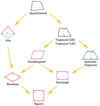Ch. 3 Flashcards
(61 cards)
synthetic proof
proof built using a system of postulates & theorems in which the prop’s of figures, but not their actual measurements r studied
justifications of synthetic proof
given statements
definitions
postulates
previously proved theorems
Bisecting Diagonals Th
If the 2 diagonals of a quadrilateral bisect each other, then the quadrilateral is a parallelogram.
implications
if-then statements that can be represented by symbols
Ex: p → q reads “If p, then q”
logically equivalent
either both true or both false
original & contrapositive
not logically equivalent
just cuz original = true, doesn’t mean converse & inverse r too
converse
q → p
If q, then p
inverse
~p → ~q
If not p, then not q
contrapositive
~q → ~p
If not q, then not p
median (of triangle)
a segment joining a vertex to the midpt of the opp. side
coordinate proof
a proof based on a coord. system in which all pts r represented by ordered pairs of #’s
justifications for coordinate proof
distance & midpt formulas
parallel lines have the same slope
perp. lines have slopes tht r neg. reciprocals of each other
a geometric figure may be placed anywhere in the coord. plane
distance formula

midpt formula

Isosceles Median Theorem
in an isosceles triangle, the medians drawn to the legs r equal in measure
isosceles trapezoid
a trapezoid w/ a line of symmetry that passes through the midpts of the bases
Isosceles Trapezoid Theorem
In an isosceles trapezoid:
- the legs r equal in measure
- the diagonals r equal in measure
- the 2 angles @ each base r equal in measure
inclusive definition
a definition that includes all possibilites
exclusive definition
a definition that excludes some possibilities
quadrilateral chart

past postulates & theorems
Addition, Subtraction, Mult, Div Prop’s of Eq Post’s
Reflexive Prop of Eq Post
Substitution Property Post
Distributive Prop. Post
If 2 angles r supp’s of same angle, then r equal in measure
if 2 angles r complements of same angle, then equal in measure
Straight Angle Post - if the sides of an angle form a straight line, then the angle is a straight angle w/ measure 180o
Angle/Segment Addition Post - For any seg or angle, the measure of the whole is equal to the sum of the measures of its non-overlapping parts
vertical angles r equal in measure
the sum of the measures of the angles of a triangle is 180o
an exterior angle of a triangle is equal in measure to the sum of the measures of its 2 remote interior angles
if 2 sides of a triangle r equal in measure, then the angles opp those sides r = in measure
if 2 angles of a triangle r =, then the sides opp those angles r =
If a tri is equilateral, then is also equiangular, w/ three 60o angles
If a tri is equiangular, then its also equilateral
if 2 parallel lines r intersected by a trans, then corr angles r =, vv
If 2 parallel lines r intersected by a trans, then alt int angles r =, vv
If 2 parallel lines r intersected by a trans, then co-int angles r supp, vv
If 2 lines r perp to the same trans, then they r parallel
If a trans = perp to one of 2 parallel lines, then its perp to the other one also
Thru a pt not on a given line, there’s 1 and only 1 parallel line to the given line
If a pt is the same distance from both endpts of a segment, then it lies on the perp bisector of the seg
A seg can be drawn perp to a given line from a pt not on the line
AA similarity - if 2 angles of 1 tri r = to 2 angles of another tri, then the 2 tri’s r similar
If a line is drawn from a pt on 1 side of a tri parallel to another side, then it forms a tri similar to the original tri
In a tri, a segment that connects the midpts of 2 sides is parallel to the 3rd side & half as long
ASA, AAS th’s
SAS, SSS Post’s
If the alt = drawn to the hyp of a right tri, then the 2 triangles formed r similar to the original tri & to each other
Pythagorean Th
If the alt is drawn to the hyp of a right tri, then the measure of the alt is the geometric mean b/w the measures of the parts of the hyp
the sum of the lengths of any 2 sides of a tri is greater than the length of the 3rd side
in an isosc tri, the medians drawn to the legs r equal in measure
in a parallelogram, the diagonals have the same midpt
In a rectangle, the diagonals r equal in measure
In a kite, the diagonals r perp to each other
in a parallelogram, opp sides r equal in measure
If a quadrilateral is a parallelogram, then consecutive angles r supp
If a quad is parallelogram, then opp angles r =
the sum of the measures of the angles of a quad = 360o
if both pairs of opp angles of a quad r equal in measure, then the quad = a parallelogram
Interior Angle Measures in Polygons Th
the sum of the angle measures of an n-gon is given by the formula
S(n) = (n - 2)180o
exterior angle measures in polygons th
the sum of the exterior angle measures of an n-gon, 1 angle at each vertex, is 360o
regular polygon
iff all its sides r equal in measure & all its angles r = in measure


